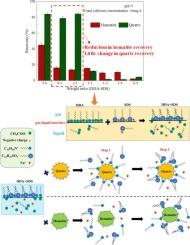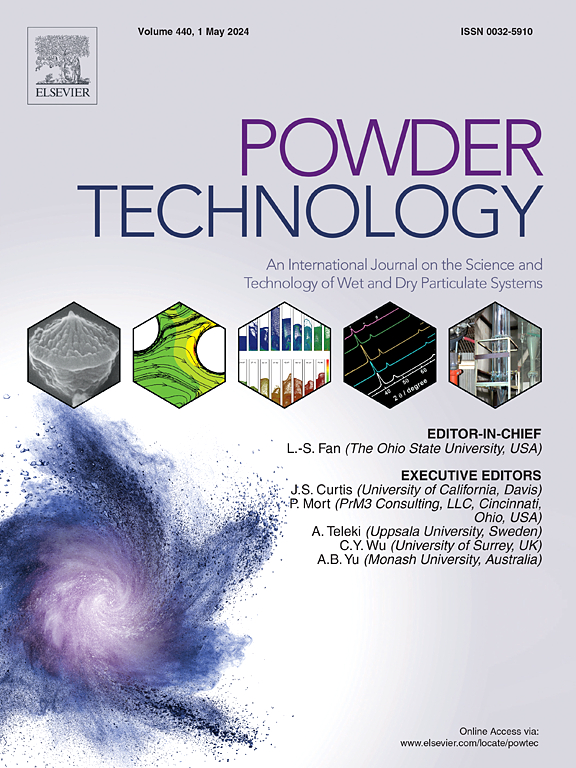十二烷基磺酸钠在以十二胺为捕收剂的赤铁矿反浮选中的功效增强
IF 4.5
2区 工程技术
Q2 ENGINEERING, CHEMICAL
引用次数: 0
摘要
精细铁矿石的阳离子反浮选面临泡沫稳定性问题,这对浮选性能产生了负面影响。通过微浮选和泡沫稳定性实验,深入研究了单一捕收剂十二胺(DDA)和十二烷基磺酸钠(SDS)以及它们的组合(DDA + SDS)对石英和赤铁矿浮选的影响。利用傅立叶变换红外光谱、X 射线光电子能谱、飞行时间二次离子质谱和 zeta 电位分析法分析了 DDA 和 SDS 之间的相互作用,以及 SDS 在 DDA 反浮选赤铁矿时的增强性能。研究结果表明,在 DDA 中按特定比例添加 SDS 可减轻与 DDA 相关的过度泡沫稳定性,并改善浮选性能。在 pH 值为 7 时,单独使用带负电荷的 SDS 无法吸附到矿物表面,但由于它们之间的强相互作用,可以与 DDA 共同吸附。虽然 SDS 在两种矿物上都有共吸附作用,但它对 DDA 在石英上的吸附影响极小,而对赤铁矿的吸附影响却大大降低,导致浮选回收率不同。造成这种差异的原因是石英和赤铁矿表面的电荷量不同,以及随后的吸附过程不同。本文章由计算机程序翻译,如有差异,请以英文原文为准。

Enhanced efficacy of sodium dodecyl sulfonate in the reverse flotation of hematite with dodecylamine as the collector
The cationic reverse flotation of fine iron ore faces the issue of foam stability, which negatively impacts the flotation performance. The effects of single collectors, dodecylamine (DDA) and sodium dodecyl sulfonate (SDS), as well as their combination (DDA + SDS), on the flotation of quartz and hematite were thoroughly examined through micro-flotation and froth stability experiments. The interactions between DDA and SDS, along with the enhanced performance of SDS in the reverse flotation of hematite with DDA, were analyzed using Fourier transform infrared spectroscopy, X-ray photoelectron spectroscopy, time-of-flight secondary ion mass spectrometry, and zeta-potential analysis. The findings indicated that adding SDS to DDA in a specific ratio alleviated the excessive froth stability associated with DDA and improved flotation performance. At pH 7, negatively charged SDS could not adsorb onto mineral surfaces when used alone but could co-adsorb with DDA due to their strong interaction. While SDS co-adsorbed on both minerals, it had minimal impact on DDA adsorption on quartz but significantly reduced it on hematite, leading to differing flotation recoveries. This discrepancy was explained by the difference in charge amounts on the quartz and hematite surfaces, as well as the subsequent adsorption processes.
求助全文
通过发布文献求助,成功后即可免费获取论文全文。
去求助
来源期刊

Powder Technology
工程技术-工程:化工
CiteScore
9.90
自引率
15.40%
发文量
1047
审稿时长
46 days
期刊介绍:
Powder Technology is an International Journal on the Science and Technology of Wet and Dry Particulate Systems. Powder Technology publishes papers on all aspects of the formation of particles and their characterisation and on the study of systems containing particulate solids. No limitation is imposed on the size of the particles, which may range from nanometre scale, as in pigments or aerosols, to that of mined or quarried materials. The following list of topics is not intended to be comprehensive, but rather to indicate typical subjects which fall within the scope of the journal's interests:
Formation and synthesis of particles by precipitation and other methods.
Modification of particles by agglomeration, coating, comminution and attrition.
Characterisation of the size, shape, surface area, pore structure and strength of particles and agglomerates (including the origins and effects of inter particle forces).
Packing, failure, flow and permeability of assemblies of particles.
Particle-particle interactions and suspension rheology.
Handling and processing operations such as slurry flow, fluidization, pneumatic conveying.
Interactions between particles and their environment, including delivery of particulate products to the body.
Applications of particle technology in production of pharmaceuticals, chemicals, foods, pigments, structural, and functional materials and in environmental and energy related matters.
For materials-oriented contributions we are looking for articles revealing the effect of particle/powder characteristics (size, morphology and composition, in that order) on material performance or functionality and, ideally, comparison to any industrial standard.
 求助内容:
求助内容: 应助结果提醒方式:
应助结果提醒方式:


